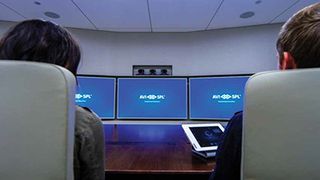- Hold on tight. Even as we speak, there’s a perceptible shift taking place in the shape of the AV business model.
Changes taking place in the integrator space are driven by a mobile workforce, BYOD, and remove capability, said AVI-SPL’s Joe Laezza.
There’s a coming together of two worlds, AV and UC, said Jeff Lowe, vice president of sales and marketing for enterprise at SMART Technologies. “Until recently they were often separate conversations.”
In the AV realm, the focus typically is on room dynamics such as room control, whiteboards and projectors, lighting, remote video, and more. On the flip side, in UC, the focus is about how to tie together a consistent communications platform for the organization.
“Can we tie audio with video together with services such as IM and chat?” Lowe asked. “That has been a key focus area for the IT player. Now these streams are coming together; there’s a meeting room conversation along with the UC platform conversation happening at the same time.”
There are inherent changes taking place in our integrator space as a whole as it relates to collaboration. “Things move quickly; Moore’s law now applies to everything technological in our lives,” said Joe Laezza, vice president of channels and services at AVI-SPL . “As a result, there are adjustments. Specifically, AVI-SPL is driven by these changes in technology and the massive movement to cloud. The mobility of the workforce, BYOD , and remote capability are the main drivers.”
And while integrators have been in the recurring revenue game for a long time in terms of on-site support and maintenance contracts, “Now, integrators are looking to expand by enabling cloud-based services,” said Ken Scaturro, president of myVRM . “This also allows the integrators to further penetrate the SME—the small to medium enterprises. The SME environment has traditionally been hosted or cloud-based as it has been cost prohibitive to build their collaboration environments on premise. As integrators build out their cloud offerings, they can serve both the SME and large enterprise markets.”
Who’s In the Driver’s Seat?

There is a much more ongoing demand relative to the integrator, with the potential for the integrator to provide an extension to the user community by delivering the technology powering the system, said AVI-SPL’s Joe Laezza. Every challenge demands a response, so the question is how will the AV design and integration business change to reflect new software, cloud, and app offerings?
“The Internet of Things is being driven by software and IP ,” Scaturro said. “The success of the AV integrators of tomorrow will be based on their understanding that software is driving the environment, and it’s an IP-based environment. Some of the pure AV players will need to transform based on this understanding. The challenge for them is whether or not they can move as fast to IP as the large system integrators are moving down into the AV space.”
Many aspects of IT have or are moving into a virtualized environment. “Many systems integrators have been doing virtualization for years while some AV integrators are just beginning to embrace this technology,” he added. “As hardware profit margins decrease, integrators will need to embrace software and virtualization skills as part of their core skill sets in order to move up the customer value chain.”
As an integrator, you need to adjust in order to help those same customers who already rely on you, said Laezza. “Our business continues to flourish as we help deliver managed, hosted, and cloud-based services, which we view as an enhancement of our services. As a professional service organization, we deliver on our core business around the design, build, and integrate concept, helping our customers build and install both AV technologies and collaborative solutions.”
Ten years ago, a customer might have come to AVI -SPL to procure and install videoconferencing equipment, operating it on their own and relying on the integrator only if it broke. “Now there is a much more ongoing demand relative to the integrator, with the potential for the integrator to provide an extension to the user community by delivering the technology powering the system,” he explained.
Often, Lowe observed, customers have a bit of a dilemma in terms of who’s leading a project. “Is it the facilities and AV side, or the IT and UC sides, or both in partnership? That’s what customers ask themselves. We ask what our delivery partner strategy is. Our challenge has been to get best of both worlds. We have recruited new partners who understand both worlds, and those are still relatively rare.”
As an example, Lowe elaborated, the SMART Room System for Lync is really another endpoint on the UC platform—both an AV and UC solution—prompting the question, “Who installs it and how is it installed? Do you need someone who provides AV room setup or Lync server configuration and cloud architecture? Or both?”
Lowe believes the meeting room is the forgotten part of a UC strategy. “That’s where we fit in; we’re putting in a collaboration solution that is a meeting room endpoint of a UC platform. I think that in a few years we’ll see less confusion as these worlds merge further.”
For his part, Laezza views all of these changes as opportunities. “Smaller shops without the ability to pivot or move on advanced services can look to their eco-systems and leverage what they’ve built to partner with larger companies. Recently, we partnered with a couple of integrators previously considered as competition. Some smaller companies, and larger ones which are vertically focused such as those in the government space, have been looking at us. I attribute this to an industry evolving into maturity.”
Karen Mitchell is a freelance writer living in Boulder, CO.











